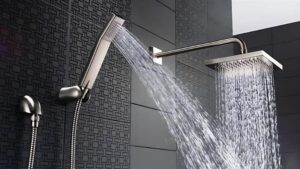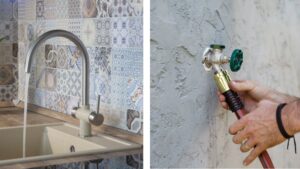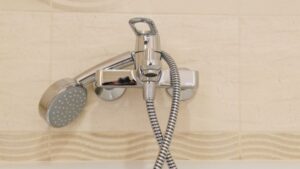There’s nothing quite as frustrating as stepping into the shower, only to be met with a weak, unsatisfying trickle of water. Low water pressure in shower heads is a common household issue that can significantly impact your daily routine.
In this article, we’ll explore the causes of this problem and provide practical solutions to help you restore your shower’s performance.

Understanding Water Pressure Basics
Before stepping into specific problems and solutions, you should first understand what constitutes normal water pressure and how to measure it.
What is normal water pressure in a shower?
Residential shower water pressure typically ranges from 40 to 60 pounds per square inch (PSI). Anything below 40 PSI is considered low pressure, while pressure above 80 PSI can be potentially damaging to your plumbing system. The ideal pressure for a comfortable shower experience usually falls between 45 and 55 PSI.
How to measure your shower water pressure?
Measuring your shower’s water pressure is a straightforward process that can help diagnose the severity of the problem. Here’s what you’ll need:
Tools Needed:
- Water pressure gauge (available at most hardware stores)
- Thread tape (optional)
- Adjustable wrench
Testing Process:
- Remove the showerhead from the pipe
- Attach the pressure gauge to the shower arm
- Turn on the water to full pressure
- Read the gauge measurement
Ideal pressure ranges for residential showers
- Below 40 PSI: Low pressure – needs attention
- 40-60 PSI: Normal range
- 45-55 PSI: Optimal range
- Above 80 PSI: Too high – may require a pressure reducer
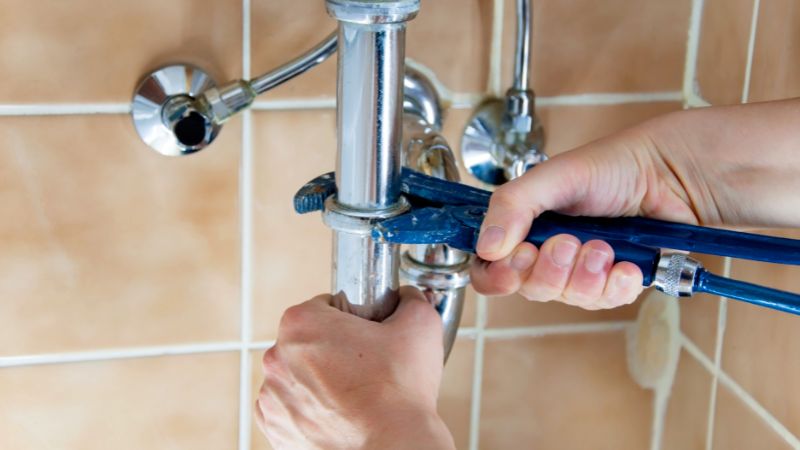
Common Causes of Low Water Pressure in Showers
| A. Internal Shower Components | B. Plumbing System Issues | C. Water Supply Factors |
| · Mineral deposit buildup
· Clogged showerhead · Faulty shower valve |
· Leaky pipes
· Corroded or aging plumbing · Inadequate pipe diameter |
· Main water valve problems
· Municipal water supply issues · Water heater complications · Peak usage timing impact |
A. Internal Shower Components
- Mineral deposit buildup
Mineral Deposit Buildup In areas with hard water, mineral deposits are often the primary culprit behind weak shower flow. Calcium and magnesium gradually accumulate inside your showerhead and pipes, creating a chalky buildup that restricts water flow. Over time, this can reduce your shower’s performance from a strong stream to a disappointing trickle.
- Clogged showerhead
Beyond mineral deposits, showerheads frequently become clogged with various debris:
- Sediment from water supply
- Rust particles from old pipes
- Sand or dirt from municipal water
- Faulty shower valve
Your shower valve controls both water flow and temperature. Common valve issues include:
- Worn washers or O-rings
- Damaged cartridges
- Scale buildup inside the mechanism
When these components fail, they can restrict water flow even if your home’s overall pressure is adequate.
B. Plumbing System Issues
- Leaky pipes
Leaky Pipes Hidden leaks can dramatically impact your shower’s performance. A single small leak might not seem significant, but it can reduce overall water pressure, lead to higher water bills, and cause structural damage if left unchecked.
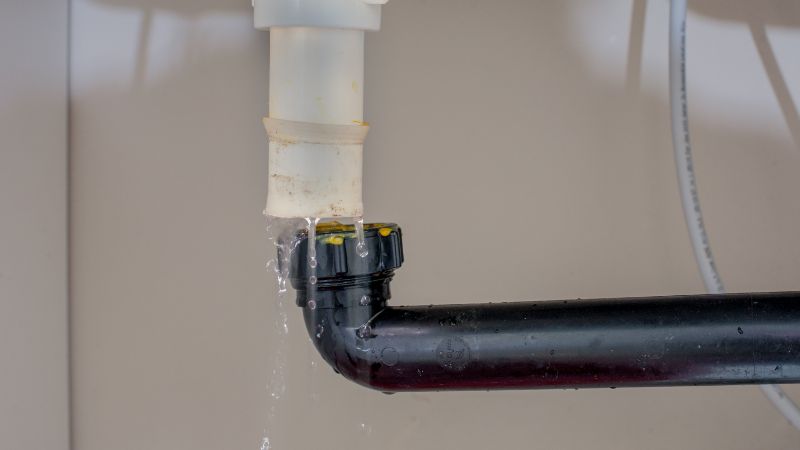
- Corroded or aging plumbing
Corroded or Aging Plumbing In older homes, deteriorating plumbing is a common pressure problem. Years of use can lead to internal corrosion and rust buildup, gradually narrowing your pipes’ internal diameter. This is particularly common in homes with galvanized steel pipes, which typically have a lifespan of 20-50 years.
- Inadequate pipe diameter
Inadequate Pipe Diameter Sometimes the issue isn’t the pipe condition but its size. Modern homes typically use larger diameter pipes than older constructions. If your home has undergone renovations or additions, mismatched pipe sizes can create pressure bottlenecks throughout your plumbing system.
C. Water Supply Factors
- Main water valve problems
The main valve controlling water flow to your home might not be fully open or could be malfunctioning. Check both the main shutoff valve near your water meter and any secondary valves installed during renovations. A partially closed valve can restrict flow to all fixtures in your home.
- Municipal water supply issues
External factors can affect your shower pressure:
- Local water main repairs
- Neighborhood development
- Seasonal changes in water supply
- Peak usage times in your area
Contact your water company if you notice sudden pressure changes affecting your entire neighborhood.
- Water heater complications
Your water heater plays a crucial role in shower performance. Common issues include:
- Sediment buildup in the tank
- Failing pressure relief valve
- Undersized unit for household needs
- Corroded or clogged pipes leading to/from the heater
- Peak usage timing impact
Water pressure often drops during high-demand periods. Consider adjusting your shower schedule to avoid:
- Early morning rush (6-9 AM)
- Evening peak times (6-10 PM)
- Simultaneous use of multiple fixtures
- Irrigation system operation times
DIY Solutions and Quick Fixes to Increase Water Pressure
Cleaning and Maintenance
Descaling showerhead
One of the most effective and simplest solutions is descaling your showerhead. Remove it from the shower arm and submerge it in white vinegar for 4-6 hours.
For stubborn mineral deposits, heat equal parts vinegar and water before soaking. After the soak, use an old toothbrush to gently scrub the spray holes, then rinse thoroughly with clean water. This simple maintenance can restore your shower’s pressure to near-original levels.
Checking and adjusting valves
Many pressure issues stem from partially closed valves, yet people often overlook this simple fix. Start by locating your shower’s shutoff valve, typically found behind an access panel or in the basement. Ensure it’s fully open by turning it counterclockwise. While you’re at it, check your home’s main water valve as well – even a slightly closed main valve can affect pressure throughout your house.
Basic pipe inspection
Walk through your home and look for these warning signs:
- Water stains on walls or ceilings
- Damp spots around visible pipes
- Corrosion on pipe surfaces
- Unusual dripping sounds
Simple Upgrades
Installing a high-pressure showerhead
Installing a high-pressure showerhead is often the most cost-effective upgrade for improving shower pressure. The process is straightforward:
- Remove the old showerhead with a wrench
- Clean the shower arm threads
- Apply new plumber’s tape
- Install the new showerhead
When selecting a new showerhead, look for models specifically designed for low-pressure situations. These units use special technology to increase water velocity and create a stronger spray pattern, even with limited water flow.
Adding a shower pressure booster
There are two main types of pressure boosters you can consider:
| Inline Shower Booster | Pump-Style Booster |
|
|
Pressure-balancing valve installation
If your shower pressure fluctuates when other fixtures are used, a pressure-balancing valve might be the answer. While installation requires moderate plumbing skills, this upgrade can provide consistent pressure regardless of other water usage in your home. The valve automatically adjusts water flow to maintain steady pressure, even when someone flushes a toilet or starts the dishwasher.
Note: Always start with the simplest solutions (cleaning and valve checks) before investing in more expensive upgrades. Most pressure issues can be resolved without major equipment purchases.

Professional Solutions to Increase Shower Water Pressure
When to Call a Plumber?
While many shower pressure issues can be resolved through DIY methods, certain situations require professional expertise.
Signs of serious plumbing issues:
- Sudden and significant pressure drops throughout your home
- Unusual noises in your plumbing system (banging, whistling, or rattling)
- Brown or rusty water coming from multiple faucets
- Visible water damage on walls or ceilings
- Consistently high water bills without explanation
Professional diagnostic process:
When you call a licensed plumber, they’ll typically conduct a thorough assessment of your plumbing system. This process starts with measuring the water pressure at various points throughout your home to identify where pressure loss occurs.
They may use video inspection equipment to examine pipe interiors, looking for issues such as hidden leaks or damage, pipe corrosion or scaling, root intrusion in main lines, and improper pipe sizing or installation.
Cost considerations:
The cost of professional plumbing services varies depending on the complexity of the problem. Most plumbers charge $75-150 for an initial visit and diagnosis, and the final cost depends.
Long-term Solutions – Pipe Replacement
Sometimes, addressing low water pressure requires more comprehensive solutions. A professional plumber can help you evaluate and implement these long-term fixes.
If your home has aging or deteriorating pipes, replacement might be the most effective solution. While this represents a significant investment, modern plumbing materials offer several advantages:
- Better flow rates due to smooth interior surfaces
- Longer lifespan (50+ years for copper and PEX piping)
- Improved resistance to scale buildup
- Better protection against future leaks
Preventive Measures
Regular maintenance tips
Establish a simple maintenance routine to prevent pressure issues. Clean your showerhead monthly with a vinegar solution and wipe nozzles regularly. Schedule professional plumbing inspections annually, especially if you live in an area with hard water. This proactive approach costs less than emergency repairs and helps maintain consistent pressure.
Water quality management
If you have hard water, invest in a water softener or filtration system. While the initial cost may seem high, these systems protect your plumbing and maintain better pressure by preventing mineral buildup. A basic shower filter can be an affordable starting point if a whole-house system isn’t feasible.
System monitoring practices
Keep track of monthly water bills for unusual changes, basic pressure readings, water color and taste changes, and unusual sounds in pipes.

Maintaining good shower pressure requires regular attention but doesn’t need to be complicated. Focus on prevention, monitor changes, and address issues promptly for the best results. However, if you’re considering an upgrade or replacement, choose the right products that meet your needs.
Elevate Your Shower Experience with Leelongs
At Leelongs, we specialize in manufacturing high-pressure showerheads designed to enhance your shower experience. Our innovative products are engineered to deliver powerful water flow, even in low-pressure situations, ensuring that you enjoy a satisfying and invigorating shower every time.
Whether you’re a contractor looking for reliable fixtures for your projects or a business seeking to provide your customers with top-notch shower solutions, Leelongs has you covered. Our commitment to quality and performance makes us a trusted partner in the market.
Explore our range of high-pressure showerheads today and discover how we can help you elevate your shower experience!

